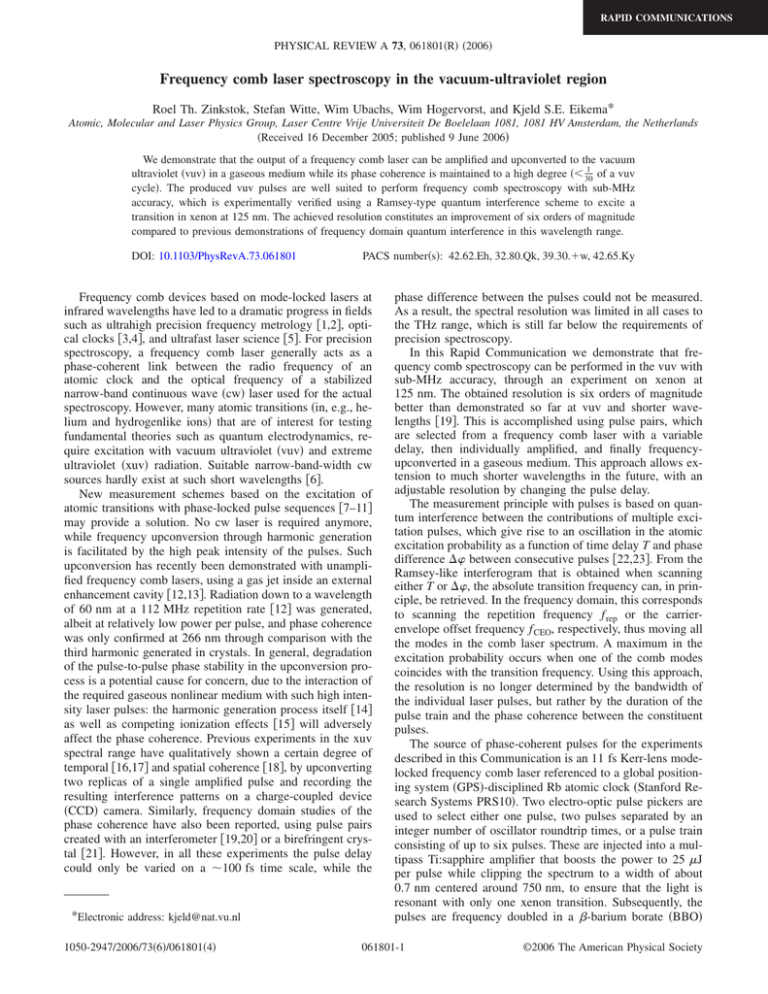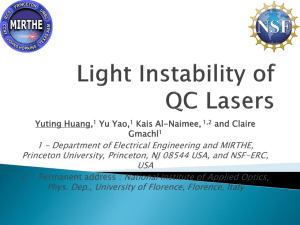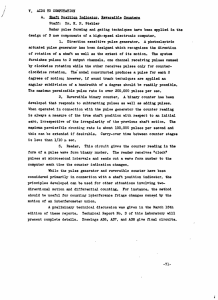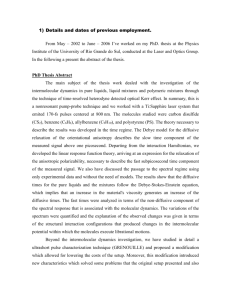Frequency comb laser spectroscopy in the vacuum-ultraviolet region *
advertisement

RAPID COMMUNICATIONS PHYSICAL REVIEW A 73, 061801共R兲 共2006兲 Frequency comb laser spectroscopy in the vacuum-ultraviolet region Roel Th. Zinkstok, Stefan Witte, Wim Ubachs, Wim Hogervorst, and Kjeld S.E. Eikema* Atomic, Molecular and Laser Physics Group, Laser Centre Vrije Universiteit De Boelelaan 1081, 1081 HV Amsterdam, the Netherlands 共Received 16 December 2005; published 9 June 2006兲 We demonstrate that the output of a frequency comb laser can be amplified and upconverted to the vacuum 1 ultraviolet 共vuv兲 in a gaseous medium while its phase coherence is maintained to a high degree 共⬍ 30 of a vuv cycle兲. The produced vuv pulses are well suited to perform frequency comb spectroscopy with sub-MHz accuracy, which is experimentally verified using a Ramsey-type quantum interference scheme to excite a transition in xenon at 125 nm. The achieved resolution constitutes an improvement of six orders of magnitude compared to previous demonstrations of frequency domain quantum interference in this wavelength range. DOI: 10.1103/PhysRevA.73.061801 PACS number共s兲: 42.62.Eh, 32.80.Qk, 39.30.⫹w, 42.65.Ky Frequency comb devices based on mode-locked lasers at infrared wavelengths have led to a dramatic progress in fields such as ultrahigh precision frequency metrology 关1,2兴, optical clocks 关3,4兴, and ultrafast laser science 关5兴. For precision spectroscopy, a frequency comb laser generally acts as a phase-coherent link between the radio frequency of an atomic clock and the optical frequency of a stabilized narrow-band continuous wave 共cw兲 laser used for the actual spectroscopy. However, many atomic transitions 共in, e.g., helium and hydrogenlike ions兲 that are of interest for testing fundamental theories such as quantum electrodynamics, require excitation with vacuum ultraviolet 共vuv兲 and extreme ultraviolet 共xuv兲 radiation. Suitable narrow-band-width cw sources hardly exist at such short wavelengths 关6兴. New measurement schemes based on the excitation of atomic transitions with phase-locked pulse sequences 关7–11兴 may provide a solution. No cw laser is required anymore, while frequency upconversion through harmonic generation is facilitated by the high peak intensity of the pulses. Such upconversion has recently been demonstrated with unamplified frequency comb lasers, using a gas jet inside an external enhancement cavity 关12,13兴. Radiation down to a wavelength of 60 nm at a 112 MHz repetition rate 关12兴 was generated, albeit at relatively low power per pulse, and phase coherence was only confirmed at 266 nm through comparison with the third harmonic generated in crystals. In general, degradation of the pulse-to-pulse phase stability in the upconversion process is a potential cause for concern, due to the interaction of the required gaseous nonlinear medium with such high intensity laser pulses: the harmonic generation process itself 关14兴 as well as competing ionization effects 关15兴 will adversely affect the phase coherence. Previous experiments in the xuv spectral range have qualitatively shown a certain degree of temporal 关16,17兴 and spatial coherence 关18兴, by upconverting two replicas of a single amplified pulse and recording the resulting interference patterns on a charge-coupled device 共CCD兲 camera. Similarly, frequency domain studies of the phase coherence have also been reported, using pulse pairs created with an interferometer 关19,20兴 or a birefringent crystal 关21兴. However, in all these experiments the pulse delay could only be varied on a ⬃100 fs time scale, while the *Electronic address: kjeld@nat.vu.nl 1050-2947/2006/73共6兲/061801共4兲 phase difference between the pulses could not be measured. As a result, the spectral resolution was limited in all cases to the THz range, which is still far below the requirements of precision spectroscopy. In this Rapid Communication we demonstrate that frequency comb spectroscopy can be performed in the vuv with sub-MHz accuracy, through an experiment on xenon at 125 nm. The obtained resolution is six orders of magnitude better than demonstrated so far at vuv and shorter wavelengths 关19兴. This is accomplished using pulse pairs, which are selected from a frequency comb laser with a variable delay, then individually amplified, and finally frequencyupconverted in a gaseous medium. This approach allows extension to much shorter wavelengths in the future, with an adjustable resolution by changing the pulse delay. The measurement principle with pulses is based on quantum interference between the contributions of multiple excitation pulses, which give rise to an oscillation in the atomic excitation probability as a function of time delay T and phase difference ⌬ between consecutive pulses 关22,23兴. From the Ramsey-like interferogram that is obtained when scanning either T or ⌬, the absolute transition frequency can, in principle, be retrieved. In the frequency domain, this corresponds to scanning the repetition frequency f rep or the carrierenvelope offset frequency f CEO, respectively, thus moving all the modes in the comb laser spectrum. A maximum in the excitation probability occurs when one of the comb modes coincides with the transition frequency. Using this approach, the resolution is no longer determined by the bandwidth of the individual laser pulses, but rather by the duration of the pulse train and the phase coherence between the constituent pulses. The source of phase-coherent pulses for the experiments described in this Communication is an 11 fs Kerr-lens modelocked frequency comb laser referenced to a global positioning system 共GPS兲-disciplined Rb atomic clock 共Stanford Research Systems PRS10兲. Two electro-optic pulse pickers are used to select either one pulse, two pulses separated by an integer number of oscillator roundtrip times, or a pulse train consisting of up to six pulses. These are injected into a multipass Ti:sapphire amplifier that boosts the power to 25 J per pulse while clipping the spectrum to a width of about 0.7 nm centered around 750 nm, to ensure that the light is resonant with only one xenon transition. Subsequently, the pulses are frequency doubled in a -barium borate 共BBO兲 061801-1 ©2006 The American Physical Society RAPID COMMUNICATIONS PHYSICAL REVIEW A 73, 061801共R兲 共2006兲 ZINKSTOK et al. FIG. 1. 共Color online兲 The setup used for vuv quantum interference spectroscopy on xenon. The inset shows a simplified level scheme of the excitation process. TOF, time-of-flight mass spectrometer. THG, third harmonic generation. crystal, yielding about 10 J per pulse at 375 nm. These 375 nm 共uv兲 pulses are focused into a gas cell filled with either oxygen or acetylene, to generate the third harmonic at 125 nm 共see Fig. 1兲. Since phase matching is not possible at this wavelength due to a positive phase mismatch in most gases, we focus the uv pulses through a 0.1 mm pinhole, and employ differential pumping to create a sudden pressure drop across the pinhole. This provides the asymmetry necessary for third harmonic generation 共THG兲, producing about 50 fJ per pulse at 125 nm. After the pinhole, the vuv radiation is collimated using a MgF2 lens and perpendicularly intersects a beam of xenon atoms. The vuv intensity is monitored using a channel electron multiplier 共Dr. Sjuts Optotechnik GmbH兲 behind a vuv filter. A second differentially pumped gas cell in front of the MgF2 lens ensures a steady gas flow away from the lens, to prevent contamination of its surface. The vuv beam is used to excite the 5p6 1S0 → 5p5 共 2 P3/2兲 5d关 21 兴1 transition at 2.398⫻ 1015 Hz 共125 nm兲 in xenon, which has a measured lifetime of 58.9 ns. The xenon beam is collimated using two skimmers, limiting its Doppler width to ⬍10 MHz. Ionization of the excited xenon atoms is done with 1.5 mJ, 30 ps frequency-doubled pulses from a synchronized Nd: YAG 共yttrium aluminum garnet兲 laseramplifier system. Ions are then detected with a time-of-flight mass spectrometer, capable of clearly resolving the various xenon isotopes. Quantum interference in the excitation process is seen when two vuv pulses are used and the time delay between them is scanned on an attosecond time scale by varying the repetition frequency of the frequency comb oscillator, while keeping the phase difference between pulses fixed. The initial delay between consecutive pulses from the frequency comb oscillator is 13.3652 ns, leading to a fringe period of 74.8212 MHz, as is shown in the first panel of Fig. 2共a兲. This time delay is changed by 12.6 attoseconds per scan step, and every data point is averaged over 10 s 共10 000 shots兲. By adding more pulses to the first two, the frequency resolution can be increased, as is shown in Fig. 2共a兲: in the limit of adding an infinite number of pulses and infinite transition lifetime, sharp modes would emerge, resembling the original frequency comb structure. We have performed measurements with pulse trains of up to six pulses. The fringes retain the 74.8 MHz period, and narrow down as expected when more pulses are added. However, the amplifier introduces slightly different phase shifts within the pulse train 共varying by a few hundred mrad兲. As a result, the excitation contributions of later pulses cause small shifts of the fringe position and an asymmetry in the fringe shape 关see Fig. 2共a兲兴, which hampers an accurate determination of the transition frequency. To obtain maximum contrast, the intensity of the vuv pulses should be matched to the surviving amplitude in the excited state, which would require an independent control over the intensity of the individual vuv pulses. In the present situation the later pulses contribute less to the final excitation amplitude, which slows down the narrowing of the interference FIG. 2. 共Color online兲 Quantum interference signals at 125 nm in 132Xe. 共a兲 Measured signals using a vuv pulse train of increasing length. 共b兲 Measured signals using two vuv pulses with increasing delays. Relative pulse intensities and time delays are shown on the left of the graphs, and the width of the resonances 共FWHM兲 is denoted in each panel. The solid lines represent fits to model interference pattern functions, allowing for an intensity difference between the excitation pulses, as well as a varying pulse-to-pulse phase shift ⌬ in graph 共a兲 due to the amplifier 共see text兲. The upper panel is identical in both graphs, as all data were acquired during the same measurement run. 061801-2 RAPID COMMUNICATIONS PHYSICAL REVIEW A 73, 061801共R兲 共2006兲 FREQUENCY COMB LASER SPECTROSCOPY IN THE¼ fringes: ideally, the six-pulse train for example should yield about 11.5 MHz wide fringes, while the measured width is 16.9 MHz. Furthermore, intensity variations in the pulse train are a cause for concern as the phase of harmonics generated in a gas, might be influenced by processes such as ionization and dissociation that create a time dependent refractive index 关21兴. Pulse intensity jitter can then lead to differences in the degree of ionization of the harmonic gas, possibly causing detrimental phase fluctuations that do not occur when crystals are used 关9兴. Although the presence of high-contrast interference fringes in Fig. 2 demonstrates that such phase fluctuations are not very large in the third harmonic generation 共THG兲 process in a gas these effects are difficult to measure quantitatively in longer pulse trains. A simple solution that enables the determination of such unknown phase shifts without loss of resolution is to use pulse pairs instead of longer pulse trains. The advantage of using two pulses is that phase shifts between the pulses caused by the amplifier system can be measured with high accuracy 关9兴, and that phase shifts in the THG process will be visible as a simple shift of the interference pattern. Note that the frequency resolution of a pulse pair spaced by, e.g., 67 ns is similar to what can be obtained with a pulse train of six pulses spaced by 13.4 ns. This is demonstrated in Fig. 2共b兲, where a series of pulse pair measurements with delays ranging from 13.4 to 67 ns is shown. The narrowest resonance that is observed has a full width at half maximum 共FWHM兲 of 7.5 MHz, which is a 13-fold improvement compared to any other measurement performed so far at such short wavelengths using nanosecond pulsed lasers 关24兴 or cw lasers 关6兴. The frequency resolution demonstrated in this measurement is 3 ⫻ 10−9, constituting an improvement of about six orders of magnitude compared to previous experiments using Michelson interferometers and ultrashort pulses 关19,20兴. The decrease in fringe contrast with increasing T as seen in Fig. 2共b兲 can be explained with a model that includes the measured pulse intensity ratios, the lifetime of the upper state, and the Doppler width, the latter being the dominant factor. By investigating transitions to longer-lived states, and reduction of the Doppler width through, e.g., cooling techniques and confinement in an ion trap, much narrower fringes can, in principle, be measured with high contrast using this method. But even from a relatively lowcontrast interferogram as shown in the bottom panel of Fig. 2共b兲 the fringe position can be extracted reliably, since the rapid sine wave oscillation allows fitting of many periods simultaneously. The control over the measurement resolution by changing the pulse delay can be used to overcome the ambiguity in the determination of the right mode when absolute frequencies are to be measured 关9,11兴. An initial measurement with sufficiently short time delay T allows identification of the mode by comparison with existing low-resolution data. Here we demonstrate 关Fig. 2共b兲兴 that the measurement accuracy can be improved by increasing T to zoom in on the transition, while keeping track of the previously determined excitation mode. This is illustrated by the dotted line in Fig. 2共b兲. Apart from the normal systematic effects in laser spectroscopy 共e.g., Doppler shift and ac Stark shift兲, the amplifier phase shift error 共6 ⫻ 25 mrad兲 together with the statistical fit un- FIG. 3. 共Color online兲 Dependence of the relative phase between the vuv pulses on the THG process in O2. Measurements of the phase shift of the quantum interference signals in xenon 共as shown in Fig. 2兲, using two vuv pulses 共a兲 as a function of the O2 pressure in the gas cell; 共b兲 as a function of incident laser pulse energy 共sum of the two pulses兲. The phase shift is set to zero at zero intensity and pressure. The light blue curves indicate the generated vuv intensity. certainty amount to an error in the vuv of about 1 MHz for T = 13.4 ns. As the pulse delay increases, the influence of the amplifier phase shifts is progressively reduced inversely proportional to T. For example, at T = 67 ns the uncertainty due to phase shifts and the fitting procedure has improved to 270 kHz 共1 ⫻ 10−10 accuracy兲. The absolute transition frequency has not been calibrated here, as no spectroscopic data with sufficient accuracy for mode identification exists at present for the studied xenon transition 共in contrast to our previous experiment on krypton at 212 关9兴兲. As this transition in itself is of no fundamental spectroscopic importance, no further efforts were undertaken to perform an initial calibration by traditional means. However, if absolute frequency measurements are to be performed the possibility of a systematic phase shift caused by the THG process needs to be investigated precisely. We have done this by systematically varying the parameters relevant to THG, in particular the gas pressure and laser intensity. The xenon atoms are now used as high-resolution vuv phase detectors, by recording twopulse interferograms with 13.365 ns time delay at various gas pressures and laser intensities. Figure 3 shows the retrieved phases when using oxygen 共O2兲 for THG. Linear fits to both curves yield slopes of −0.12 共0.29兲 mrad/ mbar 关corresponding to −1.5 共3.4兲 kHz/ mbar at the vuv frequency兴 and −8.7 共5.8兲 mrad/ J 关−104共70兲 kHz/ J兴, respectively 共1 error bars兲. Hence, no real phase shifts are observed within 1/30 of a vuv cycle, even though the vuv intensity changes by an order of magnitude and shows signs of saturation. We repeated these measurements using acetylene as the nonlinear medium, which already saturates at a pressure below 1 mbar, but displays a maximum THG efficiency at 061801-3 RAPID COMMUNICATIONS PHYSICAL REVIEW A 73, 061801共R兲 共2006兲 ZINKSTOK et al. 10 mbar, comparable to O2 at about 200 mbar. Also with acetylene, no phase shift is observed within the measurement resolution. This ensures that when a sufficiently long time delay between the pulses is used, a sub-MHz resolution can indeed be achieved. In conclusion, we have demonstrated that frequency combs can be transferred to the vuv by harmonic up-conversion in a gas while distortion of the phase coherence between subsequent comb pulses is well within 1/30 of a vuv cycle. We used these vuv pulses to excite a 125 nm transition in xenon, showing that quantum interference is a powerful tool for high-resolution spectroscopy at vuv and shorter wavelengths, possibly even down to the soft-xray regime when a more powerful amplifier is used. In addition, separate pump pulses could be used to increase the time delay between the vuv pulses, potentially improving the resolution to the kHz level. In the near future, we plan to perform measurements on the 1s2 → 1s2s two-photon transition at 2 ⫻ 120 nm in helium with a target accuracy of ⬃500 kHz, which would lead to two orders of magnitude improvement in the determination of the ground state Lamb shift 关25兴. Applying the technique of quantum interference spectroscopy to trapped ions may lead to the emergence of a new generation of ultra-precise clocks, operating in the xuv domain. 关1兴 M. Fischer et al., Phys. Rev. Lett. 92, 230802 共2004兲. 关2兴 H. S. Margolis et al., Science 306, 1355 共2004兲. 关3兴 M. Takamoto, F.-L. Hong, R. Higashi, and H. Katori, Nature 共London兲 435, 321 共2005兲. 关4兴 S. A. Diddams et al., Science 293, 825 共2001兲. 关5兴 M. Hentschel et al., Nature 共London兲 414, 509 共2001兲. 关6兴 K. S. E. Eikema, J. Walz, and T. W. Hänsch, Phys. Rev. Lett. 86, 5679 共2001兲. 关7兴 R. Teets, J. Eckstein, and T. W. Hänsch, Phys. Rev. Lett. 38, 760 共1977兲. 关8兴 M. Bellini, A. Bartoli, and T. W. Hänsch, Opt. Lett. 22, 540 共1997兲. 关9兴 S. Witte, R. Th. Zinkstok, W. Ubachs, W. Hogervorst, and K. S. E. Eikema, Science 307, 400 共2005兲. 关10兴 A. Marian, M. C. Stowe, J. R. Lawall, D. Felinto, and J. Ye, Science 306, 2063 共2004兲. 关11兴 A. Marian, M. C. Stowe, D. Felinto, and J. Ye, Phys. Rev. Lett. 95, 023001 共2005兲. 关12兴 C. Gohle et al., Nature 共London兲 436, 234 共2005兲. 关13兴 R. J. Jones, K. D. Moll, M. J. Thorpe, and J. Ye, Phys. Rev. Lett. 94, 193201 共2005兲. 关14兴 H. J. Shin et al., Phys. Rev. A 63, 053407 共2001兲. 关15兴 P. B. Corkum, Phys. Rev. Lett. 71, 1994 共1993兲. 关16兴 C. Lyngå et al., Phys. Rev. A 60, 4823 共1999兲. 关17兴 M. Bellini et al., Phys. Rev. Lett. 81, 297 共1998兲. 关18兴 R. Zerne et al., Phys. Rev. Lett. 79, 1006 共1997兲. 关19兴 M. Kovačev et al., Phys. Rev. Lett. 95, 223903 共2005兲. 关20兴 S. Cavalieri, R. Eramo, M. Materazzi, C. Corsi, and M. Bellini, Phys. Rev. Lett. 89, 133002 共2002兲. 关21兴 P. Salières et al., Phys. Rev. Lett. 83, 5483 共1999兲. 关22兴 N. F. Ramsey, Phys. Rev. 78, 695 共1956兲. 关23兴 M. M. Salour, Rev. Mod. Phys. 50, 667 共1978兲. 关24兴 Th. A. Paul and F. Merkt, J. Phys. B 38, 4145 共2005兲. 关25兴 K. S. E. Eikema, W. Ubachs, W. Vassen, and W. Hogervorst, Phys. Rev. A 55, 1866 共1997兲. This project was financially supported by the Foundation for Fundamental Research on Matter 共FOM兲, the Netherlands Organization for Scientific Research 共NWO兲, and the EU Integrated Initiative FP6 program. 061801-4





